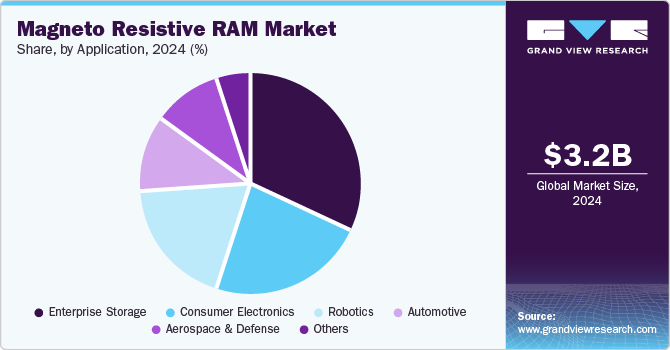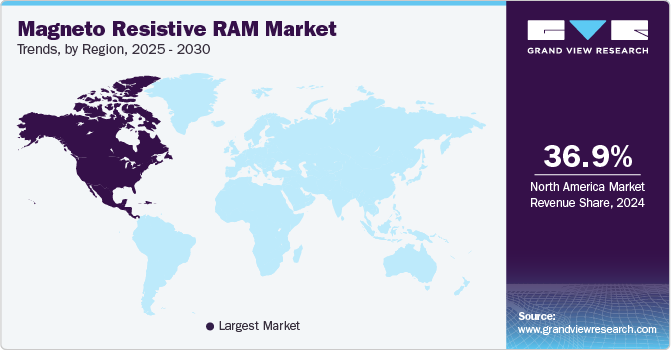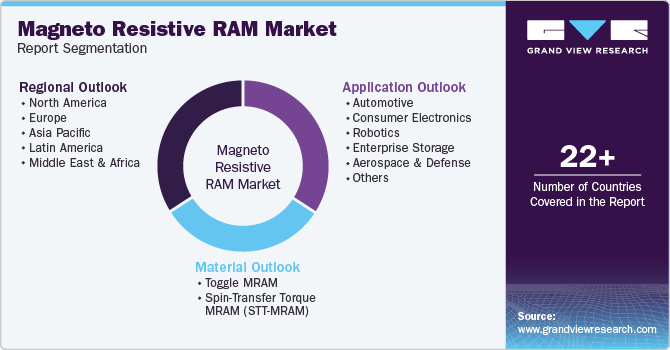
Magneto Resistive RAM Market Size, Share & Trends Analysis Report By Material (Toggle MRAM, STT-MRAM), By Application (Consumer Electronics, Robotics, Automotive), By Region, And Segment Forecasts, 2025 - 2030
- Report ID: GVR-1-68038-461-1
- Number of Report Pages: 80
- Format: PDF
- Historical Range: 2018 - 2023
- Forecast Period: 2025 - 2030
- Industry: Semiconductors & Electronics
Magneto Resistive RAM Market Trends
The global magneto resistive ram market size was valued at USD 3.19 billion in 2024 and is projected to grow at a CAGR of 38.3% from 2025 to 2030. The increasing global adoption and use of electronic devices, developments in the robotics sector, and technological advancements to improve data processing and storage are major factors driving industry growth. With a continued growth in demand for more efficient and reliable, as well as faster memory solutions, the emergence of MRAM technology is expected to transform the process of data storage and access in the coming years. MRAM offers much better performance when compared to traditional memory technologies, consuming less power, and is faster and capable of retaining data even during loss of power.

Increasing sales of wearables and flexible electronic items due to modernization and improvements in living standards are anticipated to aid market expansion. Products such as smartphones, smartwatches, gaming consoles, and laptops have witnessed steady growth in sales in recent years, compelling manufacturers to launch innovative and efficient MRAM offerings. Moreover, due to the consistent demand for miniature and flexible electronic components, the memory chip industry has witnessed technological advancements in wafer and chip manufacturing processes. MRAM memories can be easily integrated into microcontroller units (MCUs) via CMOS technology, enabling manufacturers to lower chip production costs substantially. Additionally, features such as non-volatility and lower power usage have made the use of MRAMs crucial in MCUs where power consumption is a priority.
Rapid advancements in the aerospace and defense industry due to increased investments by governments globally are anticipated to drive awareness and demand for innovative memory solutions. Aerospace applications use MRAM extensively due to their high radiation tolerance and ability to withstand extreme space conditions. Moreover, MRAM can be conveniently reprogrammed in space, enabling as many system reconfigurations as needed. These advantages have made it critical in space mission applications such as program storage, processor booting, and FPGA bitstream storage. Everspin Technologies, a U.S.-based company, has been developing space-grade MRAM for over a decade. In August 2024, the company announced a strategic partnership with Frontgrade Technologies to use its PERSYST MRAM technology in domestic electronics production for aerospace and defense.
Material Insights
The Spin-Transfer Torque MRAM (STT-MRAM) segment accounted for a dominant revenue share of 69.7% in 2024 and is expected to retain its position during the forecast period. STT-MRAM offers the advantage of high density, low power consumption, and better cost-efficiency when compared to Toggle MRAM. It is widely used in applications where data persistence is vital due to its non-volatile nature. Additionally, it offers fast write and read speeds that are generally comparable to SRAM, making it beneficial for high-performance applications. The increasing scope of application of this type of MRAM has encouraged organizations to launch advanced offerings with the aim to address evolving requirements in endpoint devices.
Meanwhile, the Toggle MRAM segment is anticipated to grow faster during the forecast period. Toggle MRAM features a non-volatile memory that makes it easier to retain data during the absence of power, thus enabling real-time collection and backup of data. The need to retain data for the long term and ensure efficient performance in extreme environments across industries such as aerospace, transportation, medical, and enterprises is anticipated to drive segment growth.
Application Insights
The enterprise storage segment accounted for a leading revenue share in 2024. Continued growth in business operations globally and the rising need to store and process large volumes of data have resulted in the extensive use of MRAM technology in this area. MRAM offers benefits such as reliable data retention, low latency, high performance due to storage of large amounts of data, and notable write endurance, making it an ideal solution to store critical data in enterprise storage applications. MRAM can be used as a write cache, read modify write buffer, and state dump cache. In case of a power loss, the memory technology can be used as a buffer to store critical data, thus improving performance and availability.

The aerospace & defense segment is expected to witness the fastest CAGR during the forecast period. Growing investments in the defense sector to modernize infrastructure and the increasing production of different types of aircraft to counter terrorism threats and conflicts through the incorporation of advanced software have created growth avenues for major market players. Companies increasingly collaborate with government organizations and research institutes to introduce innovative MRAM technologies. The aerospace sector's need to utilize radiation-hardened integrated circuits in satellites and other spacecraft to carry out exploration missions on the Moon, Mars, and other planets has presented a major opportunity to drive market demand. MRAM circuits are designed to withstand ionizing radiation and other radiation effects found in space, as their use of magnetic spintronic elements instead of conventional electron charges to store data prevents the issue of chip failure or malfunction. Their non-volatility, higher density, fast processing speed, and low power consumption have also driven their usage in this industry.
Regional Insights
North America led the market with 36.9% of the global revenue share in 2024. There is a significant demand for incorporating advanced memory technologies across various applications in sectors such as industrial, automotive, and defense, leading to the region’s substantial contribution to the global market. Moreover, a constant need to address the rising consumer demand for faster computational capabilities, better scalability, and lower power consumption in devices and applications is anticipated to enable market expansion. The presence of several notable companies developing MRAM products in the U.S. and Canada and the resulting increase in competition, has led to the frequent launch of innovative offerings suited to end-users unique requirements.

U.S. Magneto Resistive RAM Market Trends
The U.S. accounted for a dominant revenue share of the regional market in 2024. The rapid growth of the robotics, consumer electronics, and automotive industries in the economy, coupled with increasing investments in the defense & aerospace sector to modernize further and improve their operations, is anticipated to shape market growth positively.
Europe Magneto Resistive RAM Market Trends
Europe accounted for a notable revenue share of the global market in 2024. The presence of a well-established consumer electronics industry in regional economies such as Germany and the UK has highlighted the importance of embedded and standalone memory in applications such as wearable devices and smart devices. The presence of major companies such as Samsung Electronics, Honeywell, and Toshiba is further expected to enable the launch of more advanced MRAM solutions in this region over the coming years.
Germany magneto resistive ram market is an early adopter of technological advancements and innovations across various major industries such as automotive, consumer electronics, and aerospace. German companies have substantially increased their investments in research and development activities that are aimed at advancing the MRAM technology, improving its integration into existing systems, and finding promising use cases.
Asia Pacific Magneto Resistive RAM Market Trends
Asia Pacific is anticipated to emerge as the fastest-growing market during the forecast period, aided mainly by the extensive government funding for researching and producing memory chips. Additionally, rapid developments in the healthcare sector in economies such as China, Japan, and India have driven the use of the MRAM technology in medical devices to incorporate higher sensitivity and accuracy while ensuring noise reduction to improve efficiency.
China magneto resistive ram market isemerged with a leading revenue share in the Asia Pacific market for MRAM in 2024, owing to constant innovations and developments in the semiconductor & electronics industry and extensive government support. TSMC (Taiwan Semiconductor Manufacturing Company) is a major semiconductor design and contract manufacturing organization that has developed advanced offerings in this market, which have been indicated for various applications. For instance, in January 2024, the Industrial Technology Research Institute (ITRI) of Taiwan collaborated with TSMC to develop a spin-orbit-torque magnetic random-access memory (SOT-MRAM) array chip. This memory device can be used for computing in-memory architectures, offering advantages such as low latency, non-volatility, and 1% of the power consumption of spin-transfer torque MRAM.
Key Magneto Resistive RAM Company Insights
Some key companies involved in the Magneto-Resistive RAM (MRAM) market include Avalanche Technology, Everspin Technologies, and SAMSUNG.
-
Avalanche Technology is a California-based organization specializing in Spin Transfer Torque Magnetic RAM (STT-MRAM) technology. It provides STT-MRAM chips in embedded and discrete forms that can be up to 64Mb in size. Their products have been designed for critical and high-reliability applications, including defense, aerospace, industrial, and enterprise storage.
Key Magneto Resistive RAM Companies:
The following are the leading companies in the magneto resistive RAM market. These companies collectively hold the largest market share and dictate industry trends.
- Avalanche Technology
- CROCUS NANO ELECTRONICS LLC
- Everspin Technologies Inc.
- Honeywell International Inc.
- Infineon Technologies AG
- Intel Corporation
- Numem Inc.
- NVE Corporation
- SAMSUNG
- Renesas Electronics Corporation
Recent Developments
-
In August 2024, Avalanche Technology announced the addition of 64Mb and 128Mb densities to the company’s Aerospace & Defense Gen 3 STT-MRAM product suite. The new Gen 3 STT-MRAM products provide features such as high reliability and optimized radiation resilience.
Magneto Resistive RAM Market Report Scope
|
Report Attribute |
Details |
|
Market size value in 2025 |
USD 4.18 billion |
|
Revenue Forecast in 2030 |
USD 21.14 billion |
|
Growth Rate |
CAGR of 38.3% from 2025 to 2030 |
|
Base year for estimation |
2024 |
|
Historical data |
2018 - 2023 |
|
Forecast period |
2025 - 2030 |
|
Quantitative units |
Revenue in USD million and CAGR from 2025 to 2030 |
|
Report Coverage |
Revenue forecast, company ranking, competitive landscape, growth factors, and trends |
|
Segments Covered |
Material, application, region |
|
Regional scope |
North America, Europe, Asia Pacific, Latin America, MEA |
|
Country scope |
U.S., Canada, Mexico, Germany, UK, France, China, Japan, India, Australia, South Korea, Brazil, South Africa, Saudi Arabia, UAE |
|
Key companies profiled |
Avalanche Technology; CROCUS NANO ELECTRONICS LLC; Everspin Technologies Inc.; Honeywell International Inc.; Infineon Technologies AG; Intel Corporation; Numem Inc.; NVE Corporation; SAMSUNG; Renesas Electronics Corporation |
|
Customization scope |
Free report customization (equivalent up to 8 analysts working days) with purchase. Addition or alteration to country, regional & segment scope. |
|
Pricing and purchase options |
Avail customized purchase options to meet your exact research needs. Explore purchase options |
Global Magneto Resistive RAM Market Report Segmentation
This report forecasts revenue growth at the global, regional, and country levels and provides an analysis of the latest industry trends in each of the sub-segments from 2018 to 2030. For this study, Grand View Research has segmented the global Magneto Resistive RAM (MRAM) market report based on material, application, and region.

-
Material Outlook (Revenue, USD Million, 2018 - 2030)
-
Toggle MRAM
-
Spin-Transfer Torque MRAM (STT-MRAM)
-
-
Application Outlook (Revenue, USD Million, 2018 - 2030)
-
Automotive
-
Consumer Electronics
-
Robotics
-
Enterprise Storage
-
Aerospace & Defense
-
Others
-
-
Regional Outlook (Revenue, USD Million, 2018 - 2030)
-
North America
-
U.S.
-
Canada
-
Mexico
-
-
Europe
-
UK
-
Germany
-
France
-
-
Asia Pacific
-
Japan
-
India
-
China
-
Australia
-
South Korea
-
-
Latin America
-
Brazil
-
-
Middle East & Africa
-
South Africa
-
Saudi Arabia
-
UAE
-
-
We are committed towards customer satisfaction, and quality service.
"The quality of research they have done for us has been excellent."




